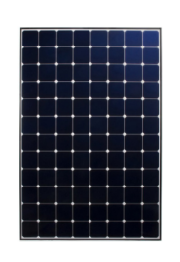Overview of system setup
The angle under which the modules are placed
The direction the modules face
The orientation of the modules

| Installed capacity | 6.9 MWp |
| Number of PV modules | 21094 |
| Number of rows | 145 |
| Number of modules in row | 146 (70 in last row) |
| Rowpace R | 4.11m |
| Field area | 162,399 m2 |
| Ground area | 27,811 m2 |
| Active area | 34,376 m2 |
| GCR | 0.17 |
| Side A | 227.47m |
| Side B | 713.94m |
The location of the PV system
The system is located in Delft. The meteorological data is taken from the weighted average of all weather stations in this province.
Latitude: 51.972
Longitude: 4.396
Overview of the used PV modules

| Technology | Monocrystalline silicon (high-efficiency) |
| Nominal power | 327 Wp |
| Size | 1.558m x 1.046m |
| STC efficiency | 20.07% |
Local temperature, irradiance and windspeed measurements
How much energy does the system produce during a year?
From the start of its operation in June 2014 until today, the virtual PV system has produced 75.48 GWh of green electricity.
This energy could have alternatively been produced from conventional fossil fuels with a total emission of 30495 tonnes of CO2 in the atmosphere [1]. This is equivalent to the amount of CO2 emitted or captured by [1], [2], [3]:
people for one year
![The typical yearly CO₂ emissions of a Dutch person are 10.45 tonnes of CO₂ [1]. People](https://pvportal-3.ewi.tudelft.nl/Media/group.png)
households for one year
![The typical yearly CO₂ production of a Dutch household for electricity consumption corresponds to 2.24 tonnes of CO₂ [1]. Households](https://pvportal-3.ewi.tudelft.nl/Media/house.png)
gallons of
gasoline
![One gallon of gasoline consumed releases 8.887 kg of CO₂ [2]. Gasoline](https://pvportal-3.ewi.tudelft.nl/Media/gasoline-pump.png)
barrels of oil
![One barrel of oil consumed releases 0.43 tonnes of CO₂ [2]. Oil](https://pvportal-3.ewi.tudelft.nl/Media/barrel.png)
tonnes of coal
![One kg of coal burned releases 0.002 tonnes of CO₂ [2]. Coal](https://pvportal-3.ewi.tudelft.nl/Media/coal.png)
tree seedlings growing for 10 years
![In 10 years 0.039 metric tonnes of CO₂ are captured per tree planted [2]. tree](https://pvportal-3.ewi.tudelft.nl/Media/tree.png)
The system performance under real-time weather data is compared with the performance predictions based on the climate data for the location. Differences between the weather conditions of this year and the average climate for the location affect the PV system performance, as shown in the figures below.
The performance ratio (PR) of the PV system is a measure for the amount of energy losses occurring in the PV system. A PR of 90% indicates that 10% of the maximum achievable energy production is lost in the PV system, for example due to the conversion efficiency of the inverter.
[2] Intergovernmental Panel on Climate Change (IPCC), IPCC Guidelines for National Greenhouse Gas Inventories , 2006.
[3] The icons used in the figure were designed by:
People: Roundicons from www.flaticon.com (licensed by CC 3.0 BY)
House, gasoline, oil, tree: Vectors Market from www.flaticon.com (licensed by CC 3.0 BY)
Coal: Freepik from www.flaticon.com (licensed by CC 3.0 BY)
How much energy did the system produce so far today?
As the virtual PV system is a megawatt-scale PV system, it would be able to produce enough energy to power a large number of households, even in winter.
Yesterday 3727 households could have run completely on electricity from the PV system.
The PVP has characterized the climate for this virtual PV system location, and it is therefore possible to provide a prediction of the system's power output during any day of the year. In reality, fluctuations in sunlight and other weather conditions cause the real-time power output to differ from that expected power production given the climate of the location.
What is the annual energy yield of this system?
The annual energy yield (EY) is the ratio of annual energy production (in kWh) to installed capacity (in kWp). A high EY can indicate that the year was particularly sunny, that the system performance in that year was high, or both. The virtual PV system simulation is active since June 2014, explaining the low EY for that year. In 2018, the implementation of a new PV system performance model in the PVP 2.0 increased the virtual PV system's performance with respect to 2015-2017. From 2020, the calculations include a mutual shading loss. However, this loss is small due to a large rowspace of 4.11m.
What are the losses of this system?
The model assumes 0% shading losses due to surrounding obstacles. However, the field-setup causes some mutual shading loss. Since the rowspace of this system is quite large, these mutual shading losses are minimal. It was calculated that on a yearly base, roughly 21MWh/year is lost due to mutual shading (DC energy). This is only 0.27% of the total yearly DC energy production.
The figure below shows which energy losses occur between the incidence of sunlight on the solar panels and the final electricity output of the PV system.
Delft
OVERVIEW
Tilt: 36°
Azimuth: 180°
Rowspace: 4.11m
Orientation: landscape
Installed Capacity: 6900000 Wp
Number of modules: 21094
Monocrystalline silicon (high-efficiency)